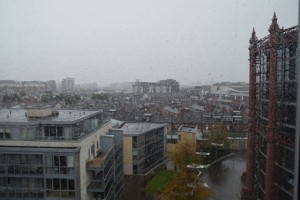14 Uisce Éireann / Irish Water
Posted by Christine on Oct 6, 2014 in Ireland | 0 comments
On a rainy day last January I was with a group of students at Kylemore Abbey, an elegant Gothic Revival edifice set by itself on a lake in Connemara. The enterprising nuns of the Abbey have a large gift store and café going there, so Kylemore is quite a tourist destination for both its beauty and its amenities. While in the bathroom that day, I noticed a gushing faucet in one of the sinks. I couldn’t make it stop running, so I reported it to someone in the café who looked like she was in charge. “Oh thanks,” she said nonchalantly, “It’s not a problem, but I’ll let someone know.”
Not a problem! Coming from Atlanta where a drought forces water restrictions on us every few years and where I try desperately to keep our own water bills under control, I was shocked. But looking at the big lake nearby, thinking about the surrounding boglands, Killary Harbour (a true fiord) just a couple of miles away, lakes and stream everywhere, and the rain pouring down at that moment, I could see why she wasn’t too worried about the gushing faucet. There is and there always has been, plenty of water in Ireland.
As of last Wednesday, 1 October 2014, however, Irish people in the Republic may begin to adopt a different attitude towards gushing faucets. On that day, they started paying for their water for the first time in history. Of course, water systems across the country have always been paid for through government spending and taxes, and water was rationed during “the Emergency,” what the neutral Irish called World War II, but this is the first time citizens have had to pay directly for the water they use.
The predictable jokes were making the rounds last week: “I guess we’ll be seeing more beards now!” “I’m coming over to your house to shower.” The newspapers have been madly calculating how much a shower or a toilet flush will cost. According to the latest estimates, the average yearly bill for two adults will be about $350—not much more than what I pay at home for one month in a hot Atlanta summer when I’m irrigating the garden. Bills will be calculated quarterly on the basis of meters or assessed charges, and those who use less will pay less. Children are “free” and there are allowances for people with illnesses requiring lots of water. On a world scale, water is still going to be pretty cheap in Ireland.
Setting up this system under the national “Irish Water” is a vast undertaking that will take many more months to complete. All the local bodies that provided clean water and removed waste water had to be brought under the one entity, meters had to be installed (a quarter of residences now have them), and a very reluctant public had to be convinced that paying for water was necessary. The Irish resistance to the property tax introduced several years ago and now to this new water tax goes very deep. Under British rule, most of the land was owned by a very small percentage of the population, the land was often neglected, and profits gained in Ireland were not necessarily reinvested in Ireland. Hit very hard by the world financial crisis of 2008, Ireland is recovering slowly, so paying for water seems more necessary to some and especially burdensome to others at this time.
On October 3rd as I am writing this, it’s raining steadily, only the third rainy day—not counting the occasional sprinkle—since I arrived in Dublin on June 29. While the good weather has been a boon to tourists like me, drought conditions were declared around the country at various times. The summer’s record-setting high temperatures and record low rainfall may have helped people think about the future of water in a changing climate and gone a little way towards reconciling them to paying for water.
There is and there always has been plenty of water in Ireland, but in the future, there may not be.

